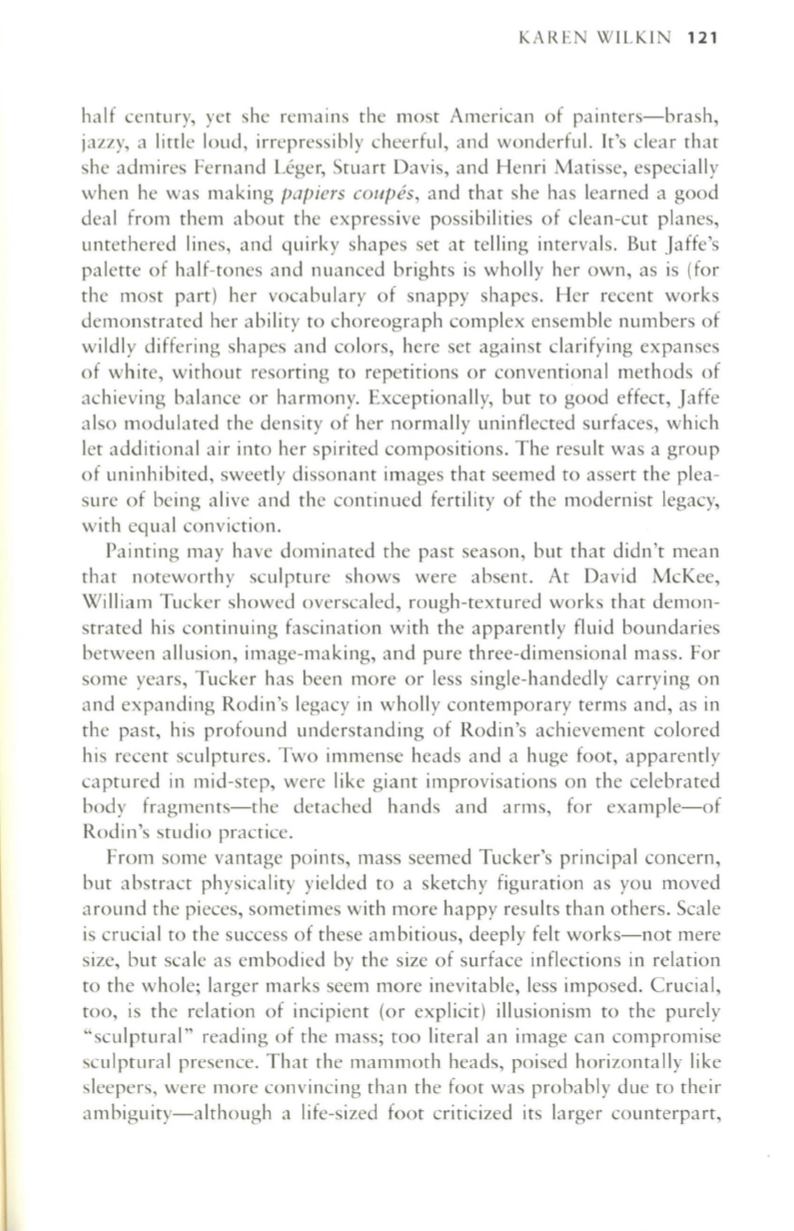
KAREN WILKIN
121
half century, yet she remains the most American of painters-brash,
jazzy, a little loud, irrepressibly cheerful, and wonderful. It's clear that
she admires Fernand Leger, Stuart Davis, and Henri Matisse, especially
when he was making
papiers coupes,
and that she has learned a good
deal from them about the expressive possibilities of clean-cut planes,
untethered lines, and quirky shapes set at telling intervals. But jaffe's
palette of half-tones and nuanced brights is wholly her own, as is (for
the most part) her vocabulary of snappy shapes. Her recent works
demonstrated her ability to choreograph complex ensemble numbers of
wildly differing shapes and colors, here set against clarifying expanses
of white, without resorting to repetitions or conventional methods of
achieving balance or harmony. Exceptionally, but to good effect, Jaffe
also modulated the density of her normally uninflected surfaces, which
let additional air into her spirited compositions. The result was a group
of uninhibited, sweetly dissonant images that seemed to assert the plea–
sure of being alive and the continued fertility of the modernist legacy,
with equal conviction.
Painting may have dominated the past season, but that didn't mean
that noteworthy sculpture shows were absent. At David McKee,
William Tucker showed overscaled, rough-textured works that demon–
strated his continuing fascination with the apparently fluid boundaries
between allusion, image-making, and pure three-dimensional mass. For
some years, Tucker has been more or less single-handedly carrying on
and expanding Rodin's legacy in wholly contemporary terms and, as in
the past, his profound understanding of Rodin's achievement colored
his recent sculptures. Two immense heads and a huge foot, apparently
captured in mid-step, were like giant improvisations on the celebrated
body fragments-the detached hands and arms, for example-of
Rodin's studio practice.
From some vantage points, mass seemed Tucker's principal concern,
but abstract physicality yielded to a sketchy figuration as you moved
around the pieces, sometimes with more happy results than others. Scale
is crucial to the success of these ambitious, deeply felt works-not mere
size, but scale as embodied by the size of surface inflections in relation
to the whole; larger marks seem more inevitable, less imposed. Crucial,
too, is the relation of incipient (or explicit) illusionism to the purely
"sculptural" reading of the mass; too literal an image can compromise
sculptural presence. That the mammoth heads, poised horizontally like
sleepers, were more convincing than the foot was probably due to their
ambiguity-although a life-sized foot criticized its larger counterpart,


